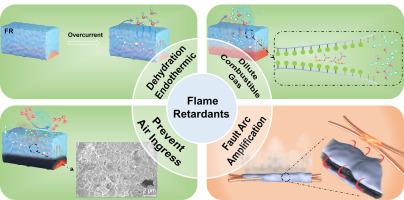The double-edged sword of flame retardants in building cables: fire suppression vs. arc hazard amplification
IF 7.4
2区 化学
Q1 POLYMER SCIENCE
引用次数: 0
Abstract
With the rapid development of modern industrial technology, the demand for power in building electrical equipment continues to rise, rendering the existing rated current standards for cables inadequate to meet actual needs. Frequent overcurrent phenomena lead to abnormal temperature rise in cables, which has become the main cause of major electrical fire accidents. To effectively enhance the related fire resistance, flame retardants are added to the insulating materials of cables. In this study, the dual role of flame retardants in PVC-sheathed building cables is investigated, focusing on their fire-suppression capabilities and potential amplification of arc hazards under overcurrent conditions. Through TG-FTIR analysis and cone calorimeter tests, it is revealed that flame retardants effectively improve the fire resistance of insulating materials by delaying thermal degradation, generating HCl earlier to dilute flammable gases, and forming a protective carbon layer. However, by systematically investigating the fault characteristics of flame-retardant (FR) and non-flame-retardant (NFR) PVC-sheathed cables under different overcurrent conditions, combined with real-time oscilloscope monitoring data, two typical types of failure modes of PVC-sheathed cables in electrical fires are identified. In addition, comparing with that observed in NFR PVC-sheathed cables, the increase of the energy of the arc and an extension of the duration of the arc in FR PVC-sheathed cables are also observed for the same failure mode. All these facts can be attributed to the coating effect of metal chlorides and metal oxides, which inadvertently facilitates wires to be closer to each other and intensifies arc formation. This study not only emphasizes the need for a comprehensive evaluation system for the selection of flame retardants, which assesses both FR performance and impact on electrical faults, but also highlights the importance of a multi-layered defense strategy in electrical fire safety, combining FR materials with arc prevention to reduce fire risks in buildings.

阻燃剂在建筑电缆中的双刃剑:灭火vs电弧危害放大
随着现代工业技术的飞速发展,建筑电气设备对电力的需求不断上升,现有的电缆额定电流标准已不能满足实际需要。频繁的过流现象导致电缆温度异常升高,已成为重大电气火灾事故的主要原因。为了有效提高电缆的耐火性能,在电缆的绝缘材料中加入阻燃剂。本文研究了阻燃剂在聚氯乙烯护套建筑电缆中的双重作用,重点研究了阻燃剂在过电流条件下的灭火能力和潜在的电弧危害放大。通过TG-FTIR分析和锥量热仪测试,发现阻燃剂通过延缓热降解、提前生成HCl稀释可燃气体、形成保护碳层等方式有效提高绝缘材料的耐火性。然而,通过系统研究阻燃(FR)和非阻燃(NFR) pvc护套电缆在不同过流工况下的故障特征,结合示波器实时监测数据,确定了电气火灾中pvc护套电缆的两种典型故障模式。此外,在相同的失效模式下,与NFR pvc护套电缆相比,FR pvc护套电缆的电弧能量增加,电弧持续时间延长。这些都是由于金属氯化物和金属氧化物的涂覆作用,使导线在不经意间相互靠近,加强了电弧的形成。本研究不仅强调了阻燃剂选择的综合评价体系的必要性,该体系既要评估阻燃材料的性能,又要评估阻燃材料对电气故障的影响,同时也强调了在电气防火安全中,多层防御策略的重要性,将阻燃材料与防弧相结合,以降低建筑物的火灾风险。
本文章由计算机程序翻译,如有差异,请以英文原文为准。
求助全文
约1分钟内获得全文
求助全文
来源期刊

Polymer Degradation and Stability
化学-高分子科学
CiteScore
10.10
自引率
10.20%
发文量
325
审稿时长
23 days
期刊介绍:
Polymer Degradation and Stability deals with the degradation reactions and their control which are a major preoccupation of practitioners of the many and diverse aspects of modern polymer technology.
Deteriorative reactions occur during processing, when polymers are subjected to heat, oxygen and mechanical stress, and during the useful life of the materials when oxygen and sunlight are the most important degradative agencies. In more specialised applications, degradation may be induced by high energy radiation, ozone, atmospheric pollutants, mechanical stress, biological action, hydrolysis and many other influences. The mechanisms of these reactions and stabilisation processes must be understood if the technology and application of polymers are to continue to advance. The reporting of investigations of this kind is therefore a major function of this journal.
However there are also new developments in polymer technology in which degradation processes find positive applications. For example, photodegradable plastics are now available, the recycling of polymeric products will become increasingly important, degradation and combustion studies are involved in the definition of the fire hazards which are associated with polymeric materials and the microelectronics industry is vitally dependent upon polymer degradation in the manufacture of its circuitry. Polymer properties may also be improved by processes like curing and grafting, the chemistry of which can be closely related to that which causes physical deterioration in other circumstances.
 求助内容:
求助内容: 应助结果提醒方式:
应助结果提醒方式:


